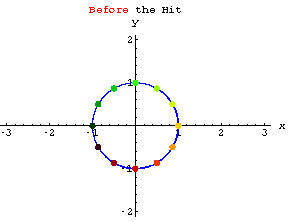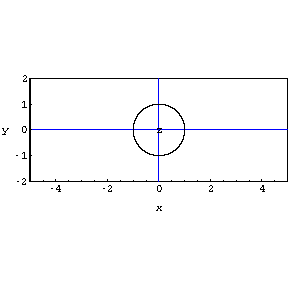Introduction
Matrix Action
Perpframes, Aligners and Hangers
Stretchers
Coordinates
Projections
SVD
Matrix Subspaces
Linear Systems, Pseudo-Inverse
Condition Number
Matrix Norm, Rank One
Data Compression
Noise Filtering
Todd Will
UW-La Crosse
More Stretchers
Stretchers
Exercises
Stretchers
Look at the action of
When you look at that action you can see why it's natural to call a diagonal matrix a "stretcher" matrix.
The diagonal matrix ![]() stretches in the x direction by a factor of "a" and in the y direction
by a factor of "b".
stretches in the x direction by a factor of "a" and in the y direction
by a factor of "b".
You can verify this by hand using the column way to multiply a matrix times a vector:
Check out a few more stretchers.


Changing dimensions
BothThe matrix ![]() sends
sends ![]() to
to ![]() .
.
But![]() sends
sends ![]() to
to ![]() .
.
Check out the action of each of these stretchers.

But note how the stretcher matrix ![]() not
only stretches the 2D circle but also embeds the ellipse into 3 dimensional
space.
not
only stretches the 2D circle but also embeds the ellipse into 3 dimensional
space.
Exercises
1. Check out the following ellipse.
![[Graphics:stretchergr36.gif]](stretchergr36.gif)
You can get this ellipse by stretching the unit circle by a factor of 3 in the x direction and a factor of 2 in the y direction.
To get the ellipse shown above I would hit the unit circle with (choose
one):
(a) the matrix ![]()
(b) the matrix ![]()
(c) the matrix ![]()
2. Check out the following ellipsoid
![[Graphics:stretchergr41.gif]](stretchergr41.gif)
You can get this ellipsoid by stretching the unit sphere by
- a factor of 4 in the x direction
- a factor of 8 in the y direction
- a factor of 2 in the z direction
(a) the matrix ![]()
(b) the matrix ![]()
(c) the matrix ![]()


![[Graphics:stretchergr40.gif]](stretchergr40.gif)